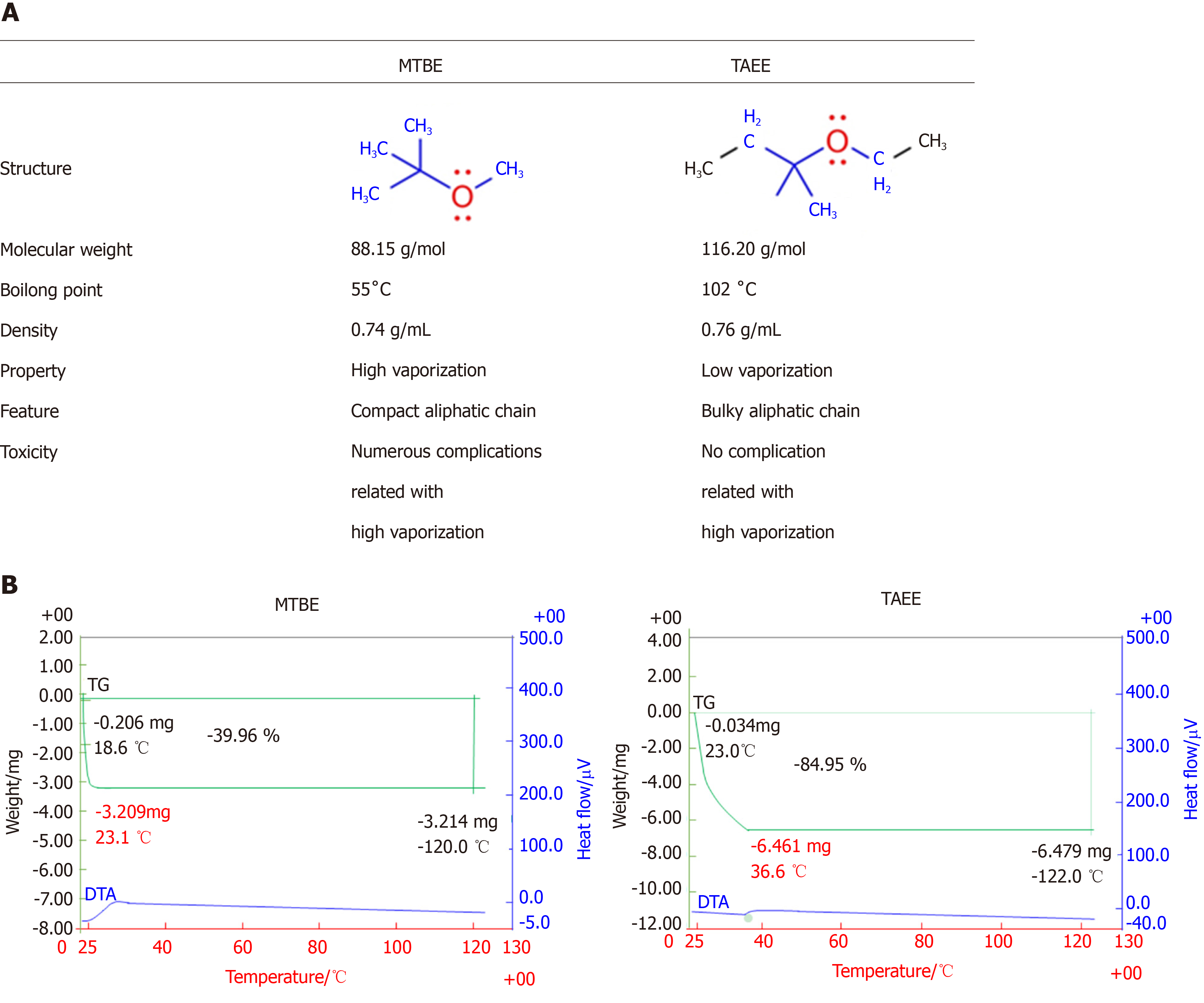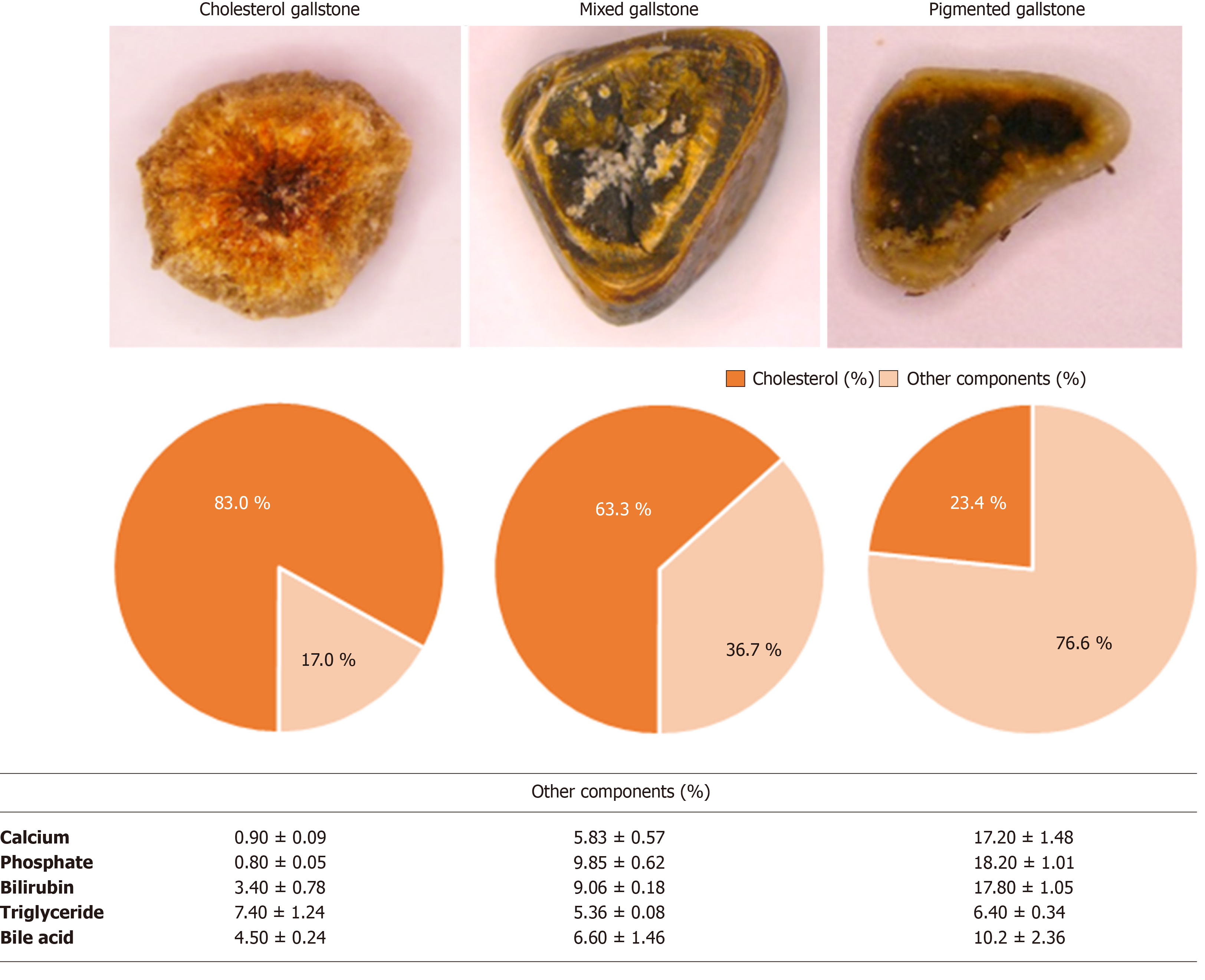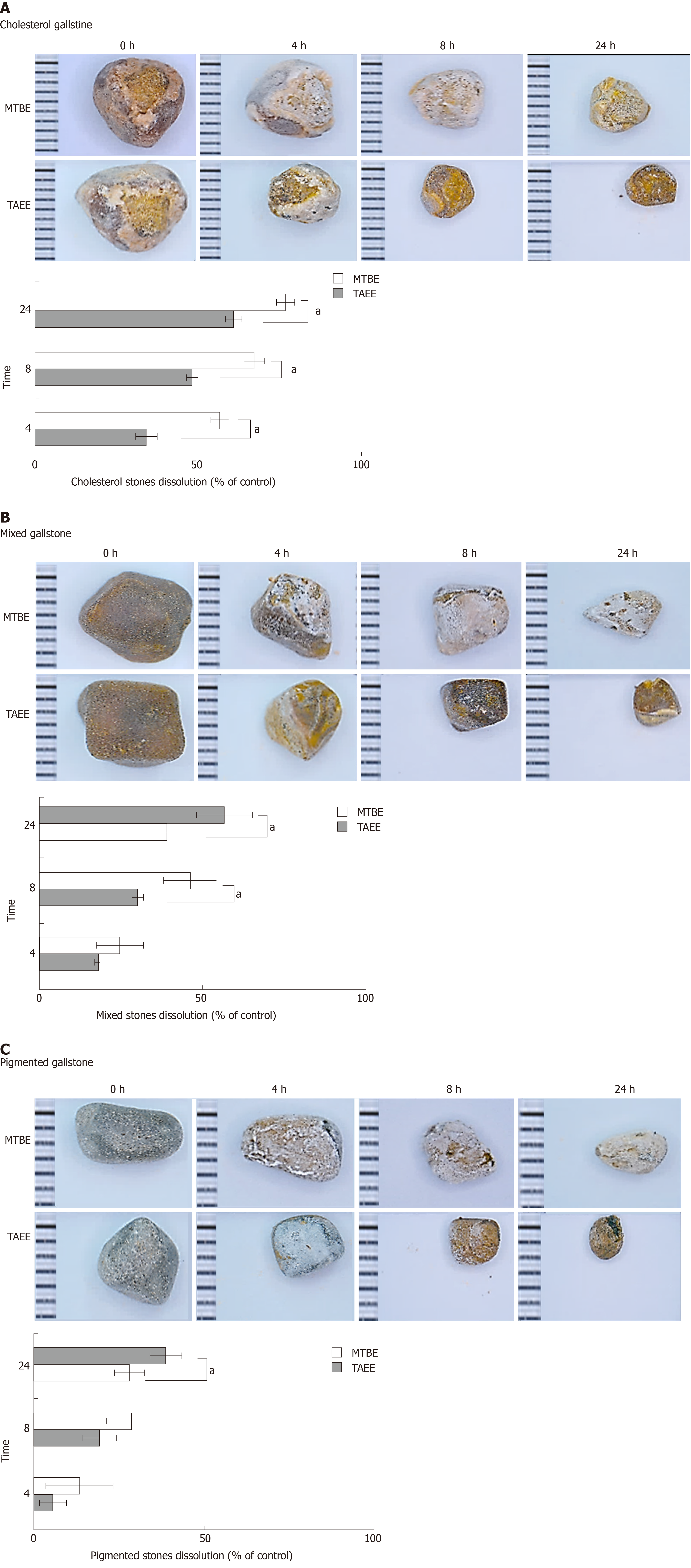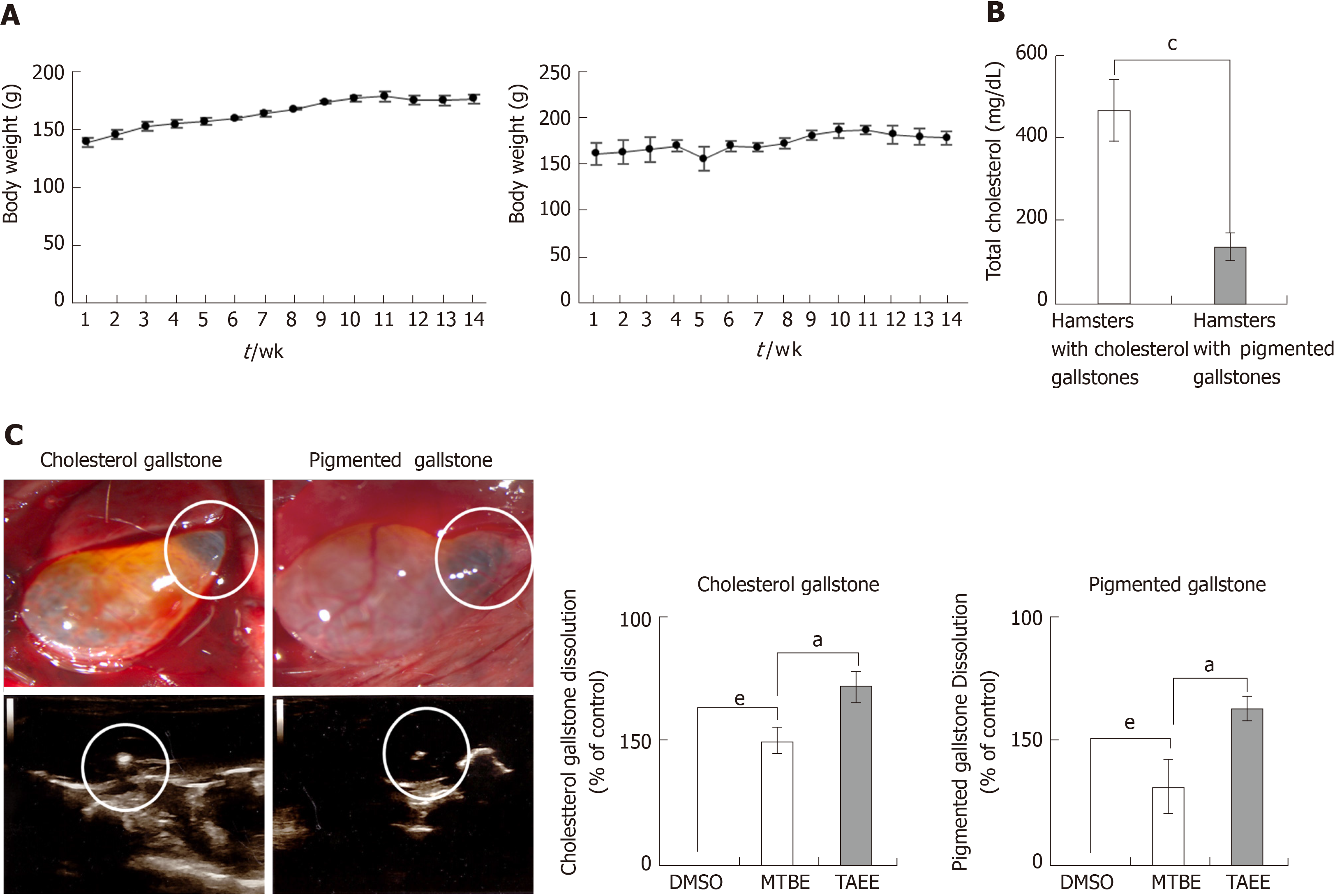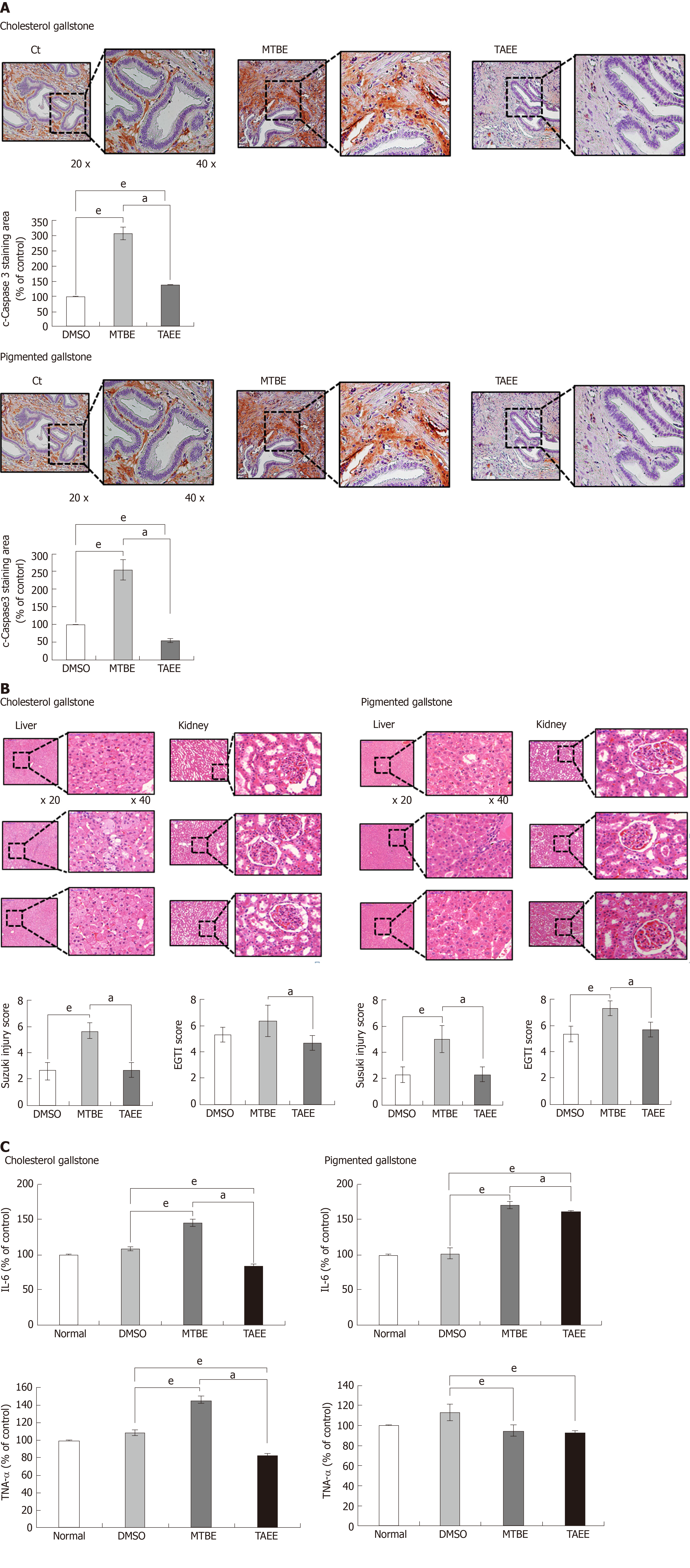Copyright
©The Author(s) 2019.
World J Gastroenterol. Oct 21, 2019; 25(39): 5936-5952
Published online Oct 21, 2019. doi: 10.3748/wjg.v25.i39.5936
Published online Oct 21, 2019. doi: 10.3748/wjg.v25.i39.5936
Figure 1 Comparison of characteristics and thermogravimetric analysis between methyl tertiary-butyl ether and tert-amyl ethyl ether.
A: Comparison of basic chemical characteristics between methyl tertiary-butyl ether (MTBE) and tert-amyl ethyl ether (TAEE); B: Thermogravimetric analysis of MTBE and TAEE for the determination of thermal stability of each solvent. TGA of MTBE could not be measured because it quickly vaporized in the chamber due to the low boiling point (Left). By contrast, TAEE was found to be vaporized slowly as the temperature increased (Right). MTBE: Methyl tertiary-butyl ether; TAEE: Tert-amyl ethyl ether.
Figure 2 The types of gallstones and the compositions of gallstones of each type.
Top: Representative cross-sectional appearances of cholesterol, mixed, and pigmented gallstones; Middle: The percentage (%) of cholesterol and the sum of the other components in the subtypes of gallstone; Bottom: The components comprising gallstones, besides cholesterol, in each group.
Figure 3 In vitro validation of gallstone dissolubility of each solvent.
A: Dissolubility exerted by each solvent for the cholesterol gallstones. Representative pictures of the residual cholesterol gallstones at 0 h, 4 h, 8 h, and 24 h after treatment (Left). Time-response graph demonstrating the dissolution of cholesterol gallstones. Tert-amyl ethyl ether (TAEE) dissolved the cholesterol gallstones significantly better than methyl tertiary-butyl ether (MTBE) after 4 h, 8 h, and 24 h (P < 0.05) (Right); B: Dissolubility exerted by each solvent for the mixed gallstones. Representative pictures of the residual mixed gallstones at 0 h, 4 h, 8 h, and 24 h after treatment (Left). Time-response graph demonstrating the dissolution of mixed gallstones. TAEE dissolved the mixed gallstones significantly better than MTBE after 4 h, 8 h, and 24 h (P < 0.05) (Right); C: Dissolubility exerted by each solvent for the pigmented gallstones. Representative pictures of the residual pigmented gallstones at 0 h, 4 h, 8 h, and 24 h after treatment (Left). Time-response graph demonstrating the dissolution of pigmented gallstones. TAEE dissolved the pigmented gallstones significantly better than MTBE after 4 h, 8 h, and 24 h (P < 0.05) (Right). Values are presented as mean ± standard deviation of three independent experiments. aP < 0.05 between MTBE and TAEE. MTBE: Methyl tert-butyl ether; TAEE: Tert-amyl ethyl ether.
Figure 4 In vivo validation of gallstone dissolubility for each solvent.
A: Weight changes of hamsters in the cholesterol gallstones (Left) and pigmented gallstones (Right) groups. During the course of the feeding protocol, the hamsters in each group showed a consistent increase in body weight; B: Comparison of serum levels of total cholesterol in the hamsters with cholesterol gallstones and pigmented gallstones, respectively; C: Representative operative and ultrasound pictures demonstrating the development of cholesterol (Left) and pigmented (Right) gallstones in the experimental hamsters following their respective protocol diets. White circles indicate the gallstones within the gallbladder; D: Determination of in vivo gallstone dissolubility for each solvent. After infusing each solvent into the gallbladders of hamsters with gallstones for 24 h, the gallstone dissolubility was determined by comparing the weights of residual gallstones in treated hamsters with those in the control hamsters [treated with dimethyl sulfoxide (DMSO)]. Tert-amyl ethyl ether (TAEE) demonstrated a significantly higher dissolubility than methyl tert-butyl ether (MTBE) in both hamster models of cholesterol (Left) and pigmented (Right) gallstones. The dissolubility for each solvent (MTBE and TAEE) for the cholesterol gallstones was 61.0% and 76.75%, respectively (P < 0.05), and the dissolubility of each solvent for pigmented gallstones was 32.0% and 47.5%, respectively. aP < 0.05 comparing between MTBE and TAEE. cP < 0.05 between hamsters with cholesterol gallstones and those with pigmented gallstones. eP < 0.05 vs control (DMSO). DMSO: Dimethyl sulfoxide; MTBE: Methyl tert-butyl ether; TAEE: Tert-amyl ethyl ether.
Figure 5 Determination of solvent toxicity in the in vivo models of gallstones.
A: Cleaved caspase-3 immunohistochemistry of the gallbladder tissues obtained from the hamsters with cholesterol (Top) and pigmented (Bottom) gallstones at 24 h after the intracystic injection of each solvent. Regarding both cholesterol and pigmented gallstones, tert-amyl ethyl ether (TAEE) infusion resulted in significantly lower expression of cleaved caspase-3 than did methyl tert-butyl ether (MTBE) infusion, suggesting a lower toxicity of TAEE compared with MTBE; B: Hematoxylin-eosin stains of the liver and kidney tissues obtained from the hamsters with cholesterol (Left) and pigmented (Right) gallstones at 24 h after the intracystic injection of each solvent. The degree of injury of the liver and kidney were calculated as the Suzuki injury scores and EGTI scores, respectively. Whereas MTBE significantly increased the injuries of the liver and kidney, TAEE did not increase the injuries in both hamster models of cholesterol and pigmented gallstones; C: ELISA results demonstrating the serum levels of pro-inflammatory cytokines, IL-6, and TNF-α in the hamster models of cholesterol (Left) and pigmented (Right) gallstones at 24 h after the intracystic injection of each solvent. In the hamsters with cholesterol gallstones, whereas MTBE significantly increased the serum levels of both IL-6 and TNF-α, TAEE rather decreased the serum levels of the cytokines. In the hamsters with pigmented gallstones, MTBE significantly increased the serum level of IL-6, and TAEE increased it, not significantly. However, both treatment groups did not increase the serum levels of TNF-α in the hamsters with pigmented gallstones. aP < 0.05 between MTBE and TAEE. eP < 0.05 vs control (dimethyl sulfoxide). aP < 0.05. DMSO: Dimethyl sulfoxide; MTBE: Methyl tert-butyl ether; TAEE: Tert-amyl ethyl ether.
Figure 6 Validation of gallstone-dissolving compound toxicity in in vitro and in vivo models.
A: Cell viability assay showing the effects of each solvent on the viability of human gallbladder epithelial cells (hGBECs). Overall, tert-amyl ethyl ether (TAEE) induced lesser significant reduction of the viability of hGBECs than did methyl tert-butyl ether (MTBE) at the tested concentrations; B: Western blot analysis showing the effects of TAEE on the expression of PCNA (a proliferation marker) and myeloid cell leukemia 1 (Mcl-1, an anti-apoptosis marker) (Left). Relative density of each group (Right). With an increasing concentration of TAEE, PCNA tended to increase progressively, and Mcl-1 tended to decrease progressively, after an initial increase; C: In vitro cytotoxicity of each solvent in Vero, L929, NIH3T3, and CHI-K1 cells. The viability of these cells did not change considerably with the concentration of MTBE or TAEE (0–1000 μM) over 24 h; D: Survival rate patterns (Left) and body weight changes (Right) after oral administration of high-dose (2000 mg/kg) of each solvent. Whereas MTBE-treated mice (n = 14) showed 21.4% (3/14) of mortality, all of which were happened within first 24 h, TAEE-treated mice (n = 14) did not show any mortality. TAEE-treated mice were found slightly underweight during the first 3 d and, subsequently, recovered thereafter; E: The effect of each solvent on locomotor activity of larval zebrafish. To determine the central nervous system (CNS) toxicity of each solvent, we tracked the locomotion of larval zebrafish after treatment with 1 mM MTBE and 1 mM TAEE, respectively, over 60 min. The locomotor activity was normalized against dimethyl sulfoxide (DMSO) as a control and presented as a percentage. During the first 6 min after treatment, TAEE did not affect the locomotor activity of zebrafish, while MTBE significantly increased it (eP < 0.05) (Right). The overall locomotor activity during 60 min. During the overall period, both treatment groups did not significantly increase the locomotor activity of zebrafish than did control group, suggesting no significantly harmful effects of MTBE and TAEE on CNS (Left). Values are presented as mean ± standard deviation of three independent experiments. aP < 0.05 between MTBE and TAEE. eP < 0.05 vs control (DMSO). gP < 0.05 vs control concentration (in MTBE), iP < 0.05 vs control concentration (in TAEE). PCNA: Proliferation cell nuclear antigen; MTBE: Methyl tert-butyl ether; TAEE: Tert-amyl ethyl ether.
- Citation: You DD, Cho SJ, Kim OH, Song JS, Hwang KS, Lee SC, Kim KH, Choi HJ, Hong HE, Seo H, Hong TH, Park JH, Lee TY, Ahn J, Jung JK, Jung KY, Kim SJ. Superior gallstone dissolubility and safety of tert-amyl ethyl ether over methyl-tertiary butyl ether. World J Gastroenterol 2019; 25(39): 5936-5952
- URL: https://www.wjgnet.com/1007-9327/full/v25/i39/5936.htm
- DOI: https://dx.doi.org/10.3748/wjg.v25.i39.5936









